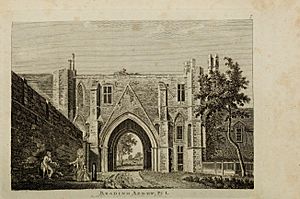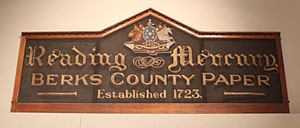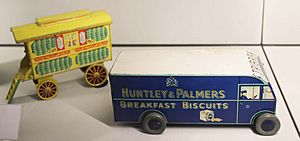Timeline of Reading, Berkshire facts for kids
The following is a timeline of the history of Reading, a major town in Berkshire, England.
Reading has a long and interesting history, from its early days as an Anglo-Saxon settlement to becoming a busy modern town. This timeline shares some of the most important moments and changes that have shaped Reading over many centuries.
Contents
Early History and Medieval Times
- 8th century – The settlement of "Readingum" is started by Anglo-Saxons. It was likely founded by the Readingas tribe where the Thames and Kennet rivers meet.
- 870 – Vikings capture Reading.
- 871 – January 4: The First Battle of Reading takes place. Vikings defend the town against soldiers from Wessex.
- 979 – The Reading Nunnery (a place for nuns) is set up by Queen Ælfthryth.
- 1006 – Vikings burn Reading.
- 1121 – June: Reading Abbey is founded by King Henry I. This was a large and important monastery. St Laurence's Church is built nearby.
- 1125 – March 29: Reading Abbey receives an important document called a charter. This date is also seen as the start of Reading School.
- c.1134 – A hospital for people with leprosy (a serious skin disease) is founded.
- 1136 – January 4 or 5: King Henry I is buried in Reading Abbey.
- 1164 – The Abbey church is officially blessed by Thomas Becket, a very important church leader.
- 1189 – The Hospitium of St John the Baptist (a guesthouse for visitors) is established.

The gateway of Reading Abbey in 1785
- 1213 – The Parliament (a meeting of important people to discuss laws) is held in Reading by King John.
- 1231 – May 2: Caversham Bridge is first mentioned in records. It had a small chapel on it.
- 1233 – The Franciscans (a group of monks) arrive in Reading.
- 1241 – Parliament is held in Reading by King Henry III.
- 1254 – The town receives its first official document, called a charter, from King Henry III. This allowed the town's merchants to form a guild (a group that protected their trade).
- 1261–4 – The famous song "Sumer Is Icumen In" is written down at Reading Abbey.
- 1295 – Reading starts sending two representatives to the Parliament as a parliamentary borough (a town with the right to elect Members of Parliament).
- 1346 – A tournament (a knightly competition) is held in Reading by King Edward III.
- 1359 – May 19: John of Gaunt, the king's son, marries Blanche of Lancaster in Reading Abbey.
- 1384 & 1389 – Parliament is held in Reading by King Richard II.
- 1434 – St Laurence's Church is rebuilt.
- 1440 – Parliament is held in Reading by King Henry VI.
- 1464 – September 14: At Reading Abbey, King Edward IV announces his secret marriage to Elizabeth Woodville.
Tudor Times and the 17th Century
- 1486 – Reading School is re-established by King Henry VII.
- 1487 – King Henry VII grants a new charter to the town.
- 1538 – As part of the Dissolution of the Monasteries, the Greyfriars monastery is closed. The Shrine of Our Lady of Caversham is destroyed.
- 1539 – September 19: Reading Abbey is closed down. Its leader, Hugh Cook Faringdon, is accused of going against the king and is executed on November 14.
- 1542 – Reading receives a royal charter allowing its citizens to elect their own mayor. Greyfriars becomes the town's meeting hall.
- 1551–5 – The Church of St Mary the Virgin is rebuilt using materials from the old Abbey church.
- 1560 – Queen Elizabeth I grants a new charter to the town.
- 1566 – The town receives its own official coat of arms.
- 1585 – Local mathematician John Blagrave publishes an important book called ‘'The Mathematical Jewel'’.
- 1619 – Wiremaking is first mentioned in Reading.
- 1625 – Law courts are temporarily moved to Reading because of a plague in London.
- 1628 – The Oracle workhouse (a place where poor people could live and work) opens.
- 1640 – Silk manufacturing begins in Reading.
- 1642 – November 4: During the English Civil War, soldiers loyal to the King (Royalists) arrive in Reading.
- 1643 – April 13–27: During the Siege of Reading, the Royalist soldiers are forced to give up to the Parliamentarian forces. The Abbey church is badly damaged.
- 1656 – Reading Blue Coat School for boys is founded.
- 1662 – The first meetings of nonconformist Protestants (those who did not follow the official Church of England) take place in Broad Street.
- 1664 – Reading gets its first fire engine.
- c. 1671 – The Quakers (another religious group) first meet in Reading.
- 1688 – December 9: During the Glorious Revolution, Dutch soldiers supporting William of Orange, with help from the townspeople, defeat Irish soldiers loyal to James II. This was the last battle fought on English soil and helped William become king.
- 1688 – Watlington House is built.
The 18th Century
- 1707 – A new wooden bridge, High Bridge, is built over the River Kennet.
- 1718–1723 – The River Kennet is made easier for boats to travel on, from High Bridge to Newbury.
- 1723 – July 8: The Reading Mercury is published, becoming Reading's first newspaper.
- 1724 – The first known freemasonry meeting takes place in Reading.
- 1748 – Reading, Pennsylvania in America is founded and named after the town in Berkshire.
- 1778 – The first modern pound lock (a system to raise and lower boats) is built at Caversham Lock on the River Thames.
- 1782 – The Green Coat school for girls is started.
- 1785 – July 25: A young Jane Austen, who would become a famous writer, attends Reading Ladies' Boarding School.
- 1785 – The Simonds Brewery (a beer-making company) is opened by William Blackall Simonds in Broad Street.
- 1786 – The Town Hall is rebuilt.
- 1788 – A new stone High Bridge is built over the River Kennet.
- 1798 – St Mary's Church, Castle Street is built.
The 19th Century

Castle Street, photographed around 1845 by Henry Fox Talbot
- 1800 – Reading's streets are first lit with oil lamps. Piped water supply is also introduced.
- 1802 – Blake's Lock on the River Kennet is changed to a modern pound lock.
- 1806 – Suttons Seeds is established, originally selling corn.
- 1810 – The Kennet and Avon Canal is completed. This allows boats to travel all the way to Bath and Bristol.
- 1813 – The first steamboat is seen on the River Thames in Reading.
- 1815 – The first gasworks (a factory making gas for lighting) opens in Reading.
- 1819 – The streets are first lit by gas.
- 1822 – Joseph Huntley starts making biscuits on London Street.
- 1829 – While teaching in Reading, inventor Isaac Holden helps develop the modern friction match.
- 1830 – Caversham Bridge is rebuilt.
- 1835 – September 9: Reading officially becomes a municipal borough (a town with its own local government).
- 1836 – The Reading Borough Police force is created.
- 1837 – December: The first stone is laid for St James's (a Roman Catholic church) on the site of Reading Abbey.
- 1839 – May 27: The Royal Berkshire Hospital opens.
- 1840 – March 30: The Great Western Railway opens its line from London Paddington to Reading railway station. This was a huge step for travel and trade.
- 1841 – Cousins Thomas Huntley and George Palmer form the famous biscuit-making company Huntley & Palmers.
- 1844 – Henry Fox Talbot, a pioneer in photography, sets up a photography business in Reading.
- 1844 – HM Prison Reading is built as the Berkshire County Gaol.
- 1850 – A public health board is set up, and work begins on a new water supply system.
- 1854 – John Heelas opens a drapery shop, which later becomes the well-known Heelas department store.
- 1856 – March 23: Forbury Gardens, a beautiful public park, opens.
- 1856 – July 9: The London and South Western Railway begins services to Reading.
- 1863 – Greyfriars Church is restored and used for worship again.
- 1868 – July: The main court sessions for Berkshire are moved from Abingdon to Reading. This makes Reading the official county town.
- 1869 – July 24: Caversham Bridge reopens after being rebuilt in metal.
- 1871 – December 25: Reading F.C. (Reading Football Club) is founded.
- 1875 – The Free Library opens.
- 1877 – Kendrick School for girls is established.
- 1879 – Horse-drawn trams start running in Reading.
- 1884 – The Maiwand Lion, a large statue, is put up in Forbury Gardens. It remembers soldiers from Berkshire who died in a war in Afghanistan.
- 1889 – April 1: Reading becomes a county borough (a larger area with more self-governance), and its boundaries are expanded.
- 1891 – Palmer Park opens.
- 1892 – September 29: The Reading University Extension College, which later becomes the University of Reading, is established.
- 1895 – November 20: Famous writer Oscar Wilde is moved to Reading Gaol (prison), where he stays until May 1897.
- 1896 – July 7: Charles Thomas Wooldridge is executed at Reading Gaol. This event inspires Oscar Wilde to write his famous poem The Ballad of Reading Gaol.
- 1896 – September 5: Reading F.C. plays its first match at Elm Park.
- 1897 – The Reading Museum opens. It has a replica of the famous Bayeux Tapestry.
The 20th Century
- 1901 – Reading's population is 72,217 people.
- 1902 – August 9: A statue of King Edward VII is put up in the town to celebrate his coronation.
- 1903 – July 22: The Reading Corporation Tramways opens its first electric tram service.
- 1909 – The first cinema opens in Reading.
- 1911 – Caversham becomes part of Reading.
- 1914 – Belgian refugees (people fleeing war) arrive in Reading.
- 1916 – Reading Gaol is used to hold foreign nationals and Irish republicans after the Easter Rising in Ireland.
- 1919 – Reading Corporation Tramways starts operating its first motor buses.
- 1920 – The first council houses (homes built by the local government) are constructed.
- 1923 – October 3: Reading Bridge, a new bridge made of reinforced concrete, opens across the River Thames.
- 1926 – March 17: The University of Reading receives its official charter, becoming a full university.
- 1926 – April: The new Caversham Bridge opens across the River Thames.
- 1929 – Easter: Reading Aerodrome (an airfield) opens at Woodley.
- 1932 – July 27: A war memorial for men of Reading and Berkshire is unveiled at the entrance to Forbury Gardens.
- 1936 – July 18: Trolleybuses (buses powered by overhead electric lines) begin operating.
- 1939 – November 20: Reading's tram services close down.
- 1943 – February 10: The Luftwaffe (German air force) carries out an air raid on Reading, killing 41 people.
- 1943 – Spring: The BBC Monitoring Service (which listens to radio broadcasts from around the world) moves to Caversham Park.
- 1945 – May 1: The BBC Monitoring Service at Caversham Park is the first place in the UK to hear about the death of Adolf Hitler, which leads to the end of World War II in Europe.
- 1947 – The University of Reading buys Whiteknights Park to build a new campus.
- 1947 – Reading becomes a twin town with Düsseldorf, Germany.
- 1947 – The River Thames floods 1600 homes in Reading.
- 1951 – The Museum of English Rural Life is established at the university.
- 1955 – People from the Caribbean start settling in Reading.
- 1958 – April 7: The first protest march for the Campaign for Nuclear Disarmament (CND) passes through Reading.
- 1960 – The town's first high-rise council flats (apartment buildings) are built.
- 1966 – The last Tilehurst brickworks (a factory making bricks) closes.
- 1968 – November 3: Reading's trolleybuses stop operating.
- 1969 – April 1: The Reading Borough Police force merges into the larger Thames Valley Police.
- 1971 – June 25–27: The first Reading Festival (a music festival) takes place.
- 1971 – Friars Walk Shopping Centre opens, and Broad Street Mall opens.
- 1974 – April 1: Reading becomes an administrative district of Berkshire.
- 1976 – March 8: The first local radio station, Radio 210, begins broadcasting.
- 1976 – Huntley & Palmers stops making biscuits in Reading.
- 1977 – The Hexagon (a concert and performance venue) is completed.
- 1985 – The new Central Library is built.
- 1988 – March 27: Reading F.C. wins the Simod Cup.
- 1989 – Bulmershe College merges with the University of Reading.
- 1990 – August 8: The Kennet and Avon Canal officially reopens for leisure boats.
- 1994 – Reading becomes a twin town with Clonmel, Ireland, and San Francisco Libre, Nicaragua.
- 1995 – The Broad Street shopping area becomes a pedestrian zone (only for people walking).
- 1997 – June 17: The Reading Rockets basketball club is formed.
- 1998 – April 1: Reading becomes a unitary authority (meaning it manages its own local services).
- 1998 – August 22: Reading F.C. plays its first match at the Madejski Stadium.
- 1999 – February: Green Park Business Park opens.
- 1999 – September 23: The Oracle shopping mall opens on the site of the old Oracle workhouse.
- 1999 – The Church of St Mary the Virgin is given the special title of Reading Minster.
The 21st Century
- 2003 – Reading becomes a twin town with Speightstown, Barbados.
- 2003 – The first gay pride march takes place in Reading.
- 2005 – November: The Green Park wind turbine is completed.
- 2006 – Reading F.C. plays its first season in the Premier League (England's top football league).
- 2010 – March: The Berkshire Brewery, a successor to the Simonds Brewery, stops production.
- 2013 – September: UTC Reading, a special technical college, opens.
- 2013 – November: HM Prison Reading closes.
- 2014 – July 17: The greatly rebuilt Reading railway station officially reopens.
- 2015 – September 30: Christchurch Bridge opens as a bridge for walkers and cyclists over the River Thames.
- 2017 – RG2 Radio, a digital radio station, is set up mainly for the local Afro-Caribbean community.
- 2018 – January 2: The electrification of Reading station is completed, meaning electric trains can now run.
- 2018 – December 15: Reading station is connected to the Elizabeth line train network.
- 2019 – November 19: Olivia Graham becomes the first female Bishop of Reading.
- 2020 – March 23: Reading enters the national lockdown due to the COVID-19 pandemic in the United Kingdom.
- 2021 – Autumn: Reading Rep Theatre opens in a new permanent venue.
- 2022 – November 6: The Elizabeth line begins running 4 trains per hour from Reading to Abbey Wood.
- 2022 – December 6: The University of Reading is ranked as the fourth greenest university in the UK.
- 2023 – May 27: Reading Green Park railway station opens to serve the Green Park business area and the Madejski Stadium.
Famous People Born in Reading
- c. 1492 – Thomas White, a cloth merchant and Lord Mayor of London.
- 1573 – October 7: William Laud, who became Archbishop of Canterbury.
- 1718 – December 12: John Cennick, an evangelical preacher.
- 1759 – September 24: Charles Simeon, another evangelical preacher.
- 1795 – May 26: Thomas Talfourd, a lawyer, politician, and author.
- 1843 – October 6: George Blackall Simonds, a sculptor.
- 1858 – June 19: George Alexander, a famous actor and theatre manager.
- 1884 – August 18: Basil Cameron, a conductor.
- 1886 – January 14: Hugh Lofting, a children's author who created Doctor Dolittle.
- 1892 – December 18: Fred Potts, a soldier who received the Victoria Cross for bravery.
- 1903 – March 29: Arthur Negus, an expert on antiques.
- 1906 – December 18: Evelyn Dunbar, a war artist.
- 1912 – July 3: Elizabeth Taylor, a novelist.
- 1929 – December 31: Peter May, a cricketer.
- 1930 – November 24: Ken Barrington, a cricketer.
- 1932 – October 24: Cormac Murphy-O'Connor, who became a Cardinal Archbishop.
- 1953 – May 15: Mike Oldfield, a musician.
- 1961 – June 25: Ricky Gervais, a famous comedian.
- 1965 – August 1: Sam Mendes, a film and theatre director.
- 1966 – August 31: Alice Oswald, a poet.
- 1973 – December 18: Lucy Worsley, a historian.
- 1975 – October 5: Kate Winslet, a famous film actress.
- 1982 – January 9: Kate Middleton, who became a member of the Royal Family.
- 1983 – September 6: Pippa Middleton, a socialite.
- 1993 – June 29: Fran Kirby, a footballer.

All content from Kiddle encyclopedia articles (including the article images and facts) can be freely used under Attribution-ShareAlike license, unless stated otherwise. Cite this article:
Timeline of Reading, Berkshire Facts for Kids. Kiddle Encyclopedia.


